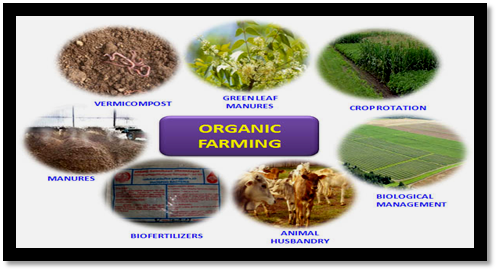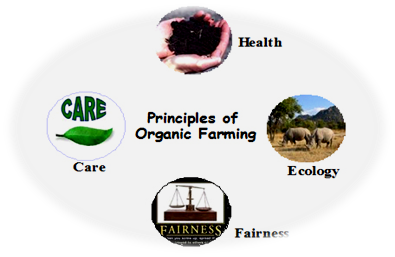Authors: Rajendra Jangid, Mahendra and Manoj
What is Organic Farming?
- Organic farming is a farming method that aims to work in harmony with nature rather than against it
- This involves using techniques to achieve good crop yields without harming the environment.
- It includes keeping and building a good soil structure and soil fertility, as well as controlling pests, diseases and weeds.
Problems with Organic Farming
- Dependency on fertilizers. Greater amount are needed every year to produce the same yields of crops
- Pests and diseases may turn more difficult to control as they become resistant to artificial pesticides
- Farming with organic methods gives smaller crops as compared to artificial farming.
- Organic farming gives low productivity of vegetables such as potatoes in the same areas where the conventional farming produces more.
- It enhances the emission of carbon dioxide and this may produces bad effect in the climate.
- As carbon dioxide is stored in these crops so it is harmful for the human life and can be dangerous for us.
- It is also known that the food which is derived from organic resources is very harmful because it produces E.coli bacterial infection
Organic farming
- Organic farming is a system which avoids or largely excludes the use of synthetic inputs (such as fertilizers, pesticides, hormones, feed additives etc) and to the maximum extent feasible rely upon crop rotations, crop residues, animal manures, off-farm organic waste, mineral grade rock additives and biological system of nutrient mobilization and plant protection.

Need of organic farming
Increase in population make compulsion to stabilize agricultural production, but to, increase it further, in sustainable manner.
Natural balance needs to be maintained at all cost for existence of life and property.
Agrochemicals which are produced from fossil fuel and are not renewable and are diminishing in availability.
It may also cost heavily on our foreign exchange in future.
Key characteristics
Protecting the long term fertility of soils by maintaining organic matter levels, encouraging soil biological activity and careful mechanical intervention.
Providing crop nutrients indirectly using relatively insoluble nutrient sources which are made available to the plant by the action of soil micro-organisms.
Nitrogen self-sufficiency through the use of legumes and biological nitrogen fixation, as well as effective recycling of organic materials including crop residues and livestock manures
Weed, disease and pest control relying primarily on crop rotations, natural predators, diversity, organic manuring, resistant varieties and limited (preferably minimal) thermal, biological and chemical intervention.
ORGANIC FARMING PRINCIPLE
Basic Steps of Organic Farming
Organic farming approach involves following five principles:
1. Conversion of land from conventional management to organic management
2. Management of the entire surrounding system to ensure biodiversity and sustainability of the system
3. Crop production with the use of alternative sources of nutrients such as crop rotation, residue management, organic manures and biological inputs.
4. Management of weeds and pests by better management practices, physical and cultural means and by biological control system.
5. Maintenance of live stock in tandem with organic concept and make them an integral part of the entire system.
Organic agriculture in India
- Organic cultivation is particularly suitable for a country like India with a huge population of small farmers who still use traditional methods of farming with few agricultural inputs.
- It is estimated that 65% of the country’s cropped area is organic by default, as the small farmers have no choice but to farm without chemical fertilizers and pesticides as they cannot afford.
- This default status coupled with India’s inherent advantages, such as, its varied agro-climatic regions, local self-sustaining agri-systems, sizeable number of progressive farmers and ready availability of inexpensive manpower translate into the potential to cultivate a vast basket of products organically.
Production
- in India is around 4.72 ha, which includes wild herbs collection from forest and maximum area having Madhya Pradesh (MP) and Uttar Pradesh followed by Rajasthan.
- The current production of organic crops is around 14,000 tons (Garibay S V and Jyoti K, 2013).
- Out of this production, tea and rice contribute around 24% each, and fruits and vegetables combine makes 17%.
| Type of Product | Products |
| Commodity | Tea, Coffee, Rice, Wheat |
| Spices | Cardamom, Black pepper, White pepper, Ginger, Turmeric, Vanilla, Tamarind, Clove, Cinnamon, Nutmeg, Mace, Chilli. |
| Pulses | Red gram, Black gram |
| Fruits | Mango, Banana, Pineapple, Passion fruit, Sugarcane, Orange, Cashew nut, Walnut. |
| Vegetables | Okra, Brinjal, Garlic, Onion, Tomato, Potato. |
| Oil seeds | Mustard, Sesame, Castor, Sunflower . |
| Others | Cotton, Herbal extracts |
Percentage share of organic products in India

Organic Certification
- Organic certification system is a quality assurance initiative, intended to assure quality, prevent fraud and promote commerce, based on set of standards and ethics.
- It is a process certification for producers of organic food and other organic products
Why Certification
- Third party assurance from producer to the consumer
- For uniform label
- Assurance to the consumers that its concern for healthy food has been addressed.
- Effective marketing tool for Image, credibility, visibility/ Transparency
Status of Organic Certification in India -2015-16
Area under organic Certification : 5.72 m ha
Cultivated Area: 1. 12 m ha
Forest Area: 5.00 m ha
Organic Certified Production : 1.54 million MT
Cultivable Production: 1.38 m MT
Wild Collection: 0.01 m MT
India Organic Exports 2015-16
- Quantity Exported: 224087 MT
Food: 207765 MT
Textiles: 18322 MT Increase over previous year: 20.3 %
Global Scenario
- Present global food market : 73.8 billion USD
- India’s total export of organic agricultural products (2015-16): 268.47 million USD
- India’s share in the global food market : 0.38 %
Top Ten Export Destination
| 1 EUROPEAN UNION | 6 JAPAN |
| 2 U.S.A. | 7 U.A.E |
| 3 CANADA | 8 MALAYSIA |
| 4 SWITZERLAND | 9 AUSTRALIA |
| 5 BANGALADESH | 10 NEWZEALAND |
| Tea | Spices |
| Pulses | Cotton |
| Sugar | Medicinal Plants |
| Basmati Rice | Processed Food |
| Oilseeds | Dry Fruits |
Key challenges in the Organic farming
Research and Development
- Large-scale investments required in R&D to develop scientifically proven PoPs
- Social science research on impact of converting to organic
- Private sector can potentially collaborate with SAUs and ICAR units for developing quality inputs
Input Level
Capacity utilization and financial viability of input units as organic inputs are yet a niche market
- Quality and regulations for inputs along with prices
- Credit support for conversion, extension information
Production level
- low yield during conversion,
- high labor requirement,
- low prices during conversion
Aggregation
- Collecting small marketable surplus from a large number of farmers
- Ensuring quality of produce Processing/Storage
- Availability of processing and storage facilities for organic produce
- Labeling requirements
Strategy for a strong organic farming
Developing a vision document for the sector
Main steam the organic sector, bring 5-10% of the cultivable area of the country under organic agriculture
On the lines of support given to the software industry, give fiscal incentives, tax holidays to encourage private sector investments
Develop a strong research and extension system to develop PoPs and outreach to give information about organic technologies and production practices
Support to the organic input industry (R&D, fiscal incentives)
Support at the farmer level – inputs, technologies, labor (link with NREGA like in the case of Maharashtra horticulture), price for organic produce
References:
INDIAN ECONOMICS PD
About Author / Additional Info:
I am currently pursuing Ph.D. in Agricultural Economics from SKRAU, Bikaner.